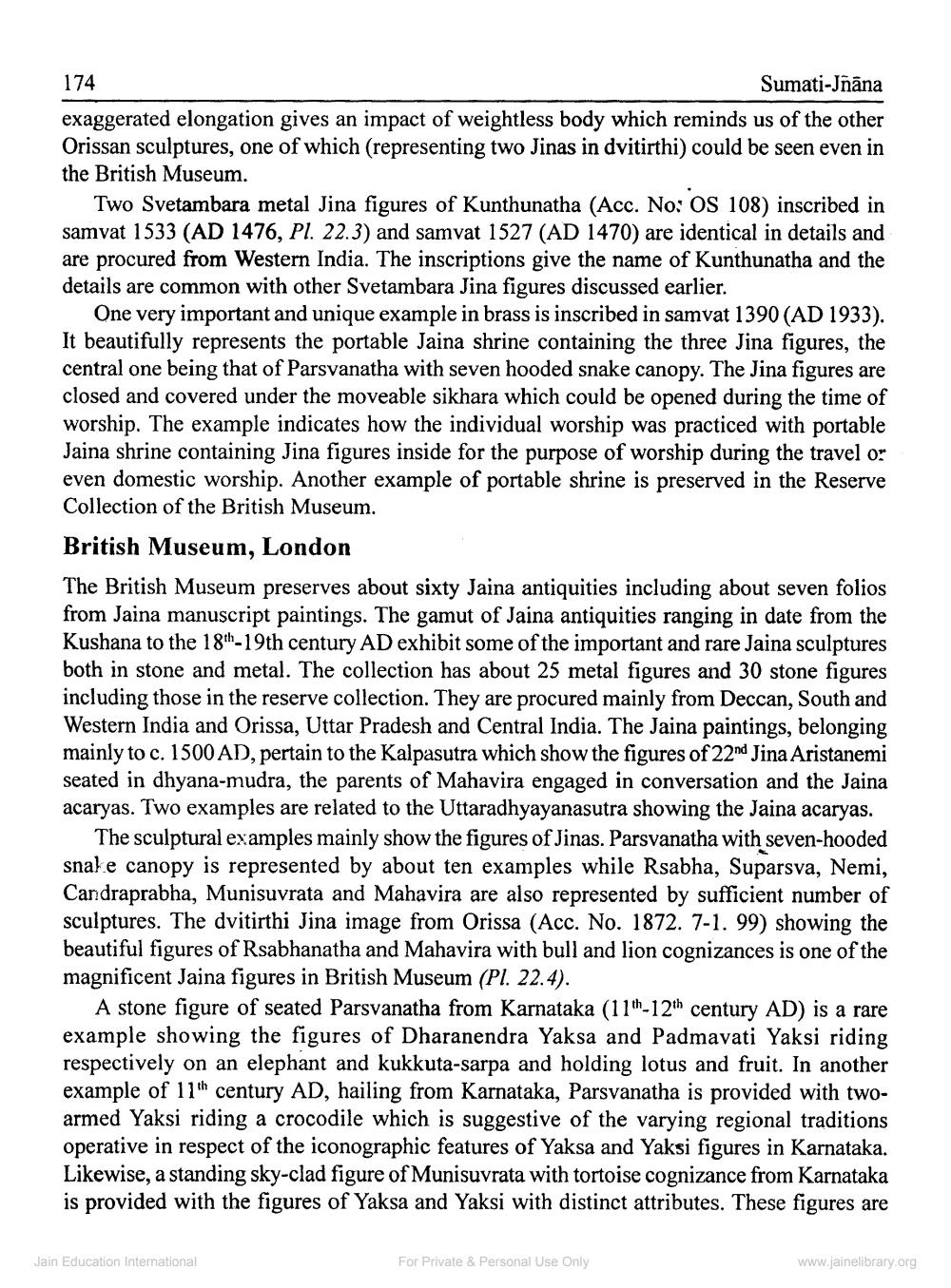________________
174
Sumati-Jnāna exaggerated elongation gives an impact of weightless body which reminds us of the other Orissan sculptures, one of which (representing two Jinas in dvitirthi) could be seen even in the British Museum.
Two Svetambara metal Jina figures of Kunthunatha (Acc. No: OS 108) inscribed in samvat 1533 (AD 1476, Pl. 22.3) and samvat 1527 (AD 1470) are identical in details and are procured from Western India. The inscriptions give the name of Kunthunatha and the details are common with other Svetambara Jina figures discussed earlier.
One very important and unique example in brass is inscribed in samvat 1390 (AD 1933). It beautifully represents the portable Jaina shrine containing the three Jina figures, the central one being that of Parsvanatha with seven hooded snake canopy. The Jina figures are closed and covered under the moveable sikhara which could be opened during the time of worship. The example indicates how the individual worship was practiced with portable Jaina shrine containing Jina figures inside for the purpose of worship during the travel or even domestic worship. Another example of portable shrine is preserved in the Reserve Collection of the British Museum. British Museum, London The British Museum preserves about sixty Jaina antiquities including about seven folios from Jaina manuscript paintings. The gamut of Jaina antiquities ranging in date from the Kushana to the 18th-19th century AD exhibit some of the important and rare Jaina sculptures both in stone and metal. The collection has about 25 metal figures and 30 stone figures including those in the reserve collection. They are procured mainly from Deccan, South and Western India and Orissa, Uttar Pradesh and Central India. The Jaina paintings, belonging mainly to c. 1500 AD, pertain to the Kalpasutra which show the figures of 22nd Jina Aristanem seated in dhyana-mudra, the parents of Mahavira engaged in conversation and the Jaina acaryas. Two examples are related to the Uttaradhyayanasutra showing the Jaina acaryas.
The sculptural examples mainly show the figures of Jinas. Parsvanatha with seven-hooded snal e canopy is represented by about ten examples while Rsabha, Suparsva, Nemi, Candraprabha, Munisuvrata and Mahavira are also represented by sufficient number of sculptures. The dvitirthi Jina image from Orissa (Acc. No. 1872. 7-1. 99) showing the beautiful figures of Rsabhanatha and Mahavira with bull and lion cognizances is one of the magnificent Jaina figures in British Museum (Pl. 22.4).
A stone figure of seated Parsvanatha from Karnataka (11th-12th century AD) is a rare example showing the figures of Dharanendra Yaksa and Padmavati Yaksi riding respectively on an elephant and kukkuta-sarpa and holding lotus and fruit. In another example of 11th century AD, hailing from Karnataka, Parsvanatha is provided with twoarmed Yaksi riding a crocodile which is suggestive of the varying regional traditions operative in respect of the iconographic features of Yaksa and Yaksi figures in Karnataka. Likewise, a standing sky-clad figure of Munisuvrata with tortoise cognizance from Karnataka is provided with the figures of Yaksa and Yaksi with distinct attributes. These figures are
Jain Education International
For Private & Personal Use Only
www.jainelibrary.org




